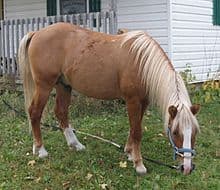Type the name of the breed you're looking for below
[wpdreams_ajaxsearchlite] Don't see the breed your're looking for? Click here and let us know!
Lac La Croix Indian Pony
| Country Of Origin | Canada |
| History and Background | Lac La Croix Indian Pony is a breed that was developed in the 1800s in Canada by the Crow Nation who lived near Lac La Croix in the province of Ontario. The lake has also given the pony their name. The breed is now critically endangered even though a program has been launched to rescue the pony. The breed is quite primitive but the ponies are known to be very healthy and hardy. Lac La Croix Indian Pony was developed in 1800 by the Crow Nation who lived in reserves around the lake Lac La Croix. As a base they used very small sample of the Canadian horse crossed with the captured Spanish mustangs Southwestern United States. During the mid-1900s the demand disappeared entirely on small ponies due to farm mechanization. Breeding on the reserves was terminated completely, and in 1960 they released the herd loose in the woods where they learned to find food. This led to the scenery around the lake being trampled by the large number of ponies and during the winter when the lake froze, the ponies could wander across the lake to the communities where they destroyed gardens and stole food. The government decided that the ponies would be culled. In 1977, there were only four mares and the race was critically endangered when no stallions remained. The rumor of the endangered breed, however, had spread down to the United States, and in February 1977, five men from Minnesota went up to the reserve in order to try and save the ponies. The men were amazed to the four mares were in good condition and was so friendly even though they had not been handled by people in at least 8-10 years. The four mares were transported to Missouri where they crossed with the Spanish mustang stallions, as the Spanish Mustang once been part of the development of the breed. Today, the number of ponies risen to about 100, but the race is still critically endangered. Lac La Croix-horses has become recognized as a separate breed and as a unique historical heritage and is under the patronage of the "Rare Breeds of Canada" Association trying to save the breed. |
| Use Today | Feral, Riding |
| Height | 12.3 and 13.3 hands high (49-53 inches, 125-135 centimeters) |
| Colour | Any colour and pattern |
| Characteristics | The original Lac La Croix pony has been described as a very similar but smaller replica of the old Canadian horse. Today, there are two different kinds of Lac La Croix Indian Pony. A - showing a greater influence of the Canadian horse, proof that the ancient genes had the greatest by power of the individual. These most closely resemble the ancient Indian ponies. B - showing more influence from the Spanish Mustang and therefore have more influence of the Canadian horses. Type B gives the impression of being somewhat smaller and easier to type than type A. The head of the pony is quite small and narrow, with a broad forehead and a straight or convex nose profile. The neck is slightly arched, well muscled, while the bow is quite narrow towards the neck. Mane and tail are usually long with heavy horsehair that sometimes can be slightly wavy. Ponies are known to have very strong tibia and rock-hard hooves. |
| Personality and Temperament | The ponies are developed in a tough, forest terrain and therefore is surefooted and very brave. They are energetic but manageable and friendly. The horses have also been shown to be very intelligent and easy to learn with great willingness to work. The ponies are suitable for riding. The breed is also inexpensive to operate and survive on meager grazing and little food. |



